
Asarum is a genus of plants in the birthwort family Aristolochiaceae, commonly known as wild ginger.
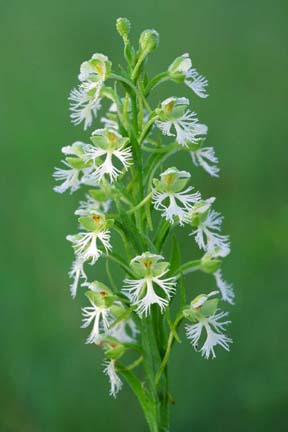
Platanthera leucophaea, commonly known as the prairie white fringed orchid or eastern prairie fringed orchid, is a rare species of orchid native to North America. It is a federally threatened species, protected since October 30, 1989 under the Endangered Species Act of 1973. In Canada, it has been listed endangered under Schedule 1 of the Species at Risk Act since 2005. In 2014, the International Union for Conservation of Nature assessed it as "least concern."

Asarum europaeum, commonly known as asarabacca, European wild ginger, hazelwort, and wild spikenard, historically cabarick, is a species of flowering plant in the birthwort family Aristolochiaceae, native to large parts of temperate Europe, and also cultivated in gardens. It is a creeping evergreen perennial with glossy green, kidney shaped leaves and solitary dull purple flowers hidden by the leaves. Though its roots have a ginger aroma, it is not closely related to the true culinary ginger Zingiber officinale, which originates in tropical Asian rainforests. It is sometimes harvested for use as a spice or a flavoring. In former days, it was used in snuff and also medicinally as an emetic and cathartic.

Asarum canadense, commonly known as Canada wild ginger, Canadian snakeroot, and broad-leaved asarabacca, is a herbaceous, perennial plant which forms dense colonies in the understory of deciduous forests throughout its native range in eastern North America, from the Great Plains east to the Atlantic Coast, and from southeastern Canada south to around the Fall Line in the southeastern United States.

Asarum caudatum is a plant native to rich moist forests of western North America. It has heart-shaped leaves and a three-lobed purplish flower.
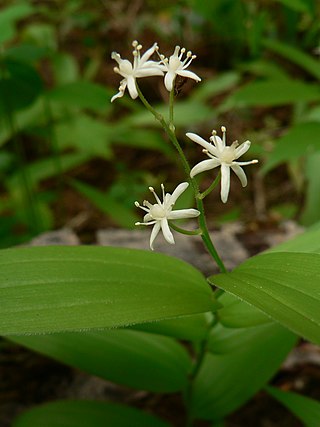
Maianthemum stellatum is a species of flowering plant, native across North America. It has been found in northern Mexico, every Canadian province and territory except Nunavut, and every US state except Hawaii and the states of the Southeast. It has little white buds in the spring, followed by delicate starry flowers, then green-and-black striped berries, and finally deep red berries in the fall.

Subularia is a genus of plants in the family Brassicaceae. Subularia species are annual herbs that grow in moist or even flooded soils. There are only two species of the genus: Subularia aquatica, which is widespread in North America and Europe; and Subularia monticola, from Africa mountains. Awlwort is a common name for plants in this genus.

Betula cordifolia, the mountain paper birch or heartleaf birch is a birch species native to Eastern Canada and the Northeastern United States. Until recently it was considered a variety of Betula papyrifera, with which it shares many characteristics, and it was classified as B. papyrifera var. cordifolia (Regel) Fern.

Mesembryanthemum cordifolium, formerly known as Aptenia cordifolia, is a species of succulent plant in the iceplant family. It is a creeping plant that forms a carpet of flat-growing perennial herbs in groups on the ground from a base. The genus name means middle-embryo flower in reference to the position of the ovary in the flower. The specific epithet is derived from Latin for heart-shaped leaves.
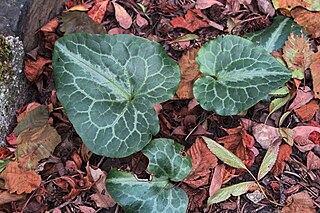
Asarum hartwegii is a species of wild ginger known by the common name Hartweg's wild ginger.
Asarum marmoratum is a species of wild ginger known by the common name marbled wild ginger.

Myristica fragrans is an evergreen tree indigenous to the Maluku Islands of Indonesia. It is important as the main source of the spices nutmeg and mace. It is widely grown across the tropics including Guangdong and Yunnan in China, Taiwan, Indonesia, Malaysia, Grenada in the Caribbean, Kerala in India, Sri Lanka and South America.

Mirabilis nyctaginea is a species of flowering plant in the four o'clock family known by several common names, including wild four o'clock, heartleaf four o'clock, and heartleaf umbrella wort.

Prunus caroliniana, known as the Carolina laurelcherry, Carolina cherry laurel, Carolina cherry, or Cherry laurel, is a small evergreen flowering tree native to the lowlands of Southeastern United States, from North Carolina south to Florida and westward to central Texas. The species also has escaped into the wild in a few places in California.
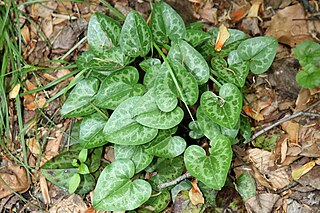
Hexastylis naniflora is a rare species of flowering plant in the birthwort family known by the common name dwarf-flowered heartleaf. It is endemic to the Piedmont region of the United States, where it is limited to a small area straddling the border between North Carolina and South Carolina. It is a federally listed threatened species.

Yucca aloifolia is the type species for the genus Yucca. Common names include aloe yucca, dagger plant, and Spanish bayonet. It grows in sandy soils, especially on sand dunes along the coast.

Quercus similis, the swamp post oak or bottomland post oak, is an oak species native to the southeastern and south-central United States. The greatest concentration of populations is in Louisiana and Arkansas, Mississippi, and eastern Texas, with isolated population in Missouri, Alabama, and the Coastal Plain of Georgia and South Carolina.
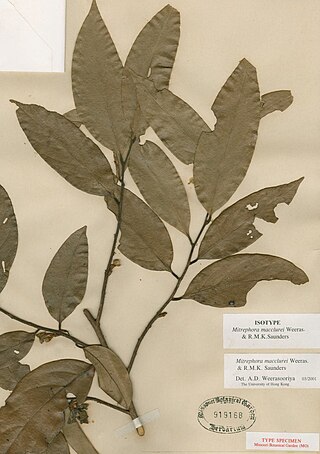
Mitrephora macclurei is a species of plant in the family Annonaceae. It is native to China, Laos and Vietnam. Aruna Weerasooriya and Richard Saunders, the botanists who first formally described the species, named it after Floyd Alonzo McClure of Lingnan University, who collected the holotype specimen that they examined.

Drypetes arguta, commonly known as the water ironplum, is a species of small tree or large bush in the family Putranjivaceae. It is native to tropical East Africa. It was first described in 1920 by the English botanist John Hutchinson, who named it Cyclostemon argutus. It was later transferred to the genus Drypetes.

Holubia is a monotypic genus of flowering plants belonging to the family Pedaliaceae. The only species is Holubia saccata.




















